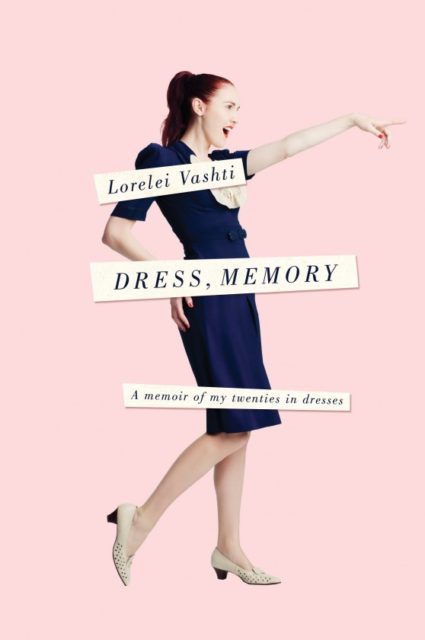The ‘blog to book’ transition has become normalised enough that it forms the basis of many conference or festival panels around the country, featuring successful writers who went their own way or who caught the attention from publishers with their blogging activities.
One of these writers is Lorelei Vashti. Her blog ‘Dress, memory’ (dressmemory.com) was born from a desire to be more creative, and so every Friday from May to November 2011 she posted about a dress she wore in her twenties. Within a month her project had attracted the attention of three publishers; that number eventually grew to five. An “extraordinary” situation, as Lorelei freely admits. Some will ask – how did you get that kind of traction so quickly?
“I guess I’d started it [the blog] going ‘This is a good idea’. I could sort of tell, you know when you have an idea and it is so concise you can pitch it to someone in one sentence. I realised I could explain it to people: it’s a memoir of my twenties in dresses. It was concise and beautiful and I didn’t need to ramble or explain it more than what it was.”
I asked Lorelei – What the hardest part of the ‘blog to book’ process?
“I found the structure the trickiest thing, at least to begin with. I think I spent the whole first year just experimenting with different ways I could present the stories in the book. The blog was fragmentary and poetic: it didn’t rely on narrative or plot, it was literally just ‘flashes’ of scenes and memories, so I didn’t need to worry about chronology or suspense, or getting the reader to keep turning the pages.
But with the book, I finally settled on a narrative that moved chronologically from the year I was twenty to the year I was thirty. I couldn’t treat the stories as filmic ‘scenes’ any more, i.e. short stories that could be read in any order. I had to build up the plot, and actually take my readers on a journey. I found that very difficult, and my writing style changed completely as a result. In the book, it was so much more difficult to sustain the lyrical style and intensity that I was aiming to achieve on the blog, so they really are two very different beasts now.”
She has some final words of advice: “Coming from a publishing background, I was really aware of how differently we read printed material compared to online stuff… I think I’d encourage other blog-to-book writers to spend some time thinking about the different ways that readers interact with the two things, and how the structure of the online material might work differently in a book. It’s crass, but I do think it comes down to: if you’re asking someone to pay $30 for a book, you want to be giving them something they can’t find online for free.
This year Lorelei has become a mother. I asked her what these early months of motherhood have taught her about artistic identity and focus, and how she’s managing to keep a hold on these. This was something that was very important to me when my two were little.
“Even before becoming a mum I had always been interested in that intersection between art and life, and how life can both feed and impede art,” she says. “The short answer is that I have learned that I can’t do it alone and that if I want to keep writing and working, I need help with childcare!
The long answer is a bit more flowery. I was optimistic that having a baby would hopefully add a lot more to my creative life, but I wasn’t sure if this was just a fantasy, and that once she was here all my plans for my artistic career would go out the window. I’ve always had a sort of old-school bohemian admiration of women who seem to be bursting out of the seams of their lives, whose days look perhaps kind of messy but they are alive with kids and art and love and music and colour—that always looked like so much fun to me, and to be honest, I was looking forward to having a kid throw everything into chaos because I’d had a very quiet and necessarily dull couple of years just focused on writing the book! But I can recognise the fantasy aspect of this now—kids need your constant attention, so it’s obviously not always possible to do your own thing and that can be frustrating.
So far though I’ve found that I’m more productive with writing. Especially in those first three months, I discovered I could really get a lot of words down when she was sleeping beside me. If anything, I’m finding it’s getting more difficult now: at four months, she’s much more a person, she needs more ‘awake’ time where I’m with her, reading her stories and taking her with me on walks so she can look at stuff. I am quietly dreading (and in perfect contradiction also looking forward to!) how ‘on’ I’m going to have to be when she starts crawling, let alone walking! Maybe I will never write another word after that, and my artistic identity will fall away for about ten years until I can take a breath again? I don’t know. So, I guess I’m taking it day by day.
These first few months have reminded me that if I do want to write something though—like, if there is a burning desire to get a story out—I AM able to do it, by hook or by crook. For example, I really wanted to write about the birth: for some reason I just needed to get that story out, so I spent most of those first three months of her life working on that story. I’m sure it’s not my best work—I was distracted and confused about what I was trying to say—but I got it out and I feel like it’s done now and I can move on. (It’ll be published in Kill Your Darlings later in the year.)”
Here is the cover of Lorelei’s gorgeous book Dress, Memory.

Dress, Memory is released this month and can be ordered through Booktopia.
I can’t wait to read it!


















